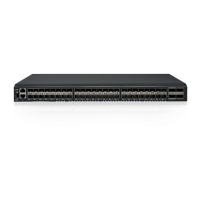Preparing for Installation
TABLE 6
Installation and basic system configuration
Task Task details or additional information Completed
Mount the device. Choose one of the following mounting options:
• Mount the device as a standalone unit. Refer to Standalone installation on page
26.
• Mount the device in a four-post rack. Refer to Universal four-post rack
installation on page 26.
• Mount the device in a two-post rack. Refer to Universal two-post rack
installation on page 39.
Check the airflow of the power supply
and fan assembly
The airflow direction of the power supply and fan should match. The power
supplies and fan trays are clearly labeled with either a green arrow with an "E", or
an orange arrow with an "I." For more details, refer to Identifying the airflow
direction on page 77.
Gather all components required for the
initial setup.
Refer to Items required on page 51.
Provide power to the device. Refer to Providing power to the device on page 51.
Attach a management station, establish
a serial connection, and change the
default passwords (optional).
Refer to Establishing a first-time serial connection on page 52. After completing
this task, log in to the serial port to configure the device.
Set the IP address, subnet mask, and
the default gateway IP address.
Use the ipaddrset command to configure a static device IP address, subnet mask,
and gateway IP address, or you can use a DHCP server to obtain the information
dynamically. Refer to Configuring the IP address on page 53.
Set the date and time.
• Use the date command to display and set the date and time.
• Use the tstimezone command to display and set the time zone.
• Use the tsclockserver command to synchronize the time with an external NTP
server.
Customize the switch name and chassis
name.
Refer to Setting the date and time on page 53 for more information.
• Use the swicthname command to change the default switch name.
• Use the chassisname command to change the default chassis name.
Refer to Customizing the chassis name and switch name on page 55 for more
information.
Establish an Ethernet connection. By establishing an Ethernet connection, you can complete the device configuration
using a serial session, Telnet, or management application, such as IBM Network
Advisor. Refer to Establishing an Ethernet connection on page 56.
Optional: Configure the DNS service. Use the dnsconfig command to create DNS server entries. Refer to the Fabric OS
Administrator's Guide.
Optional: Customize the domain ID. Use the configure command to change the domain ID (default ID is 1). Refer to
Setting the domain ID on page 56 for more information.
22 Hardware Installation Guide

